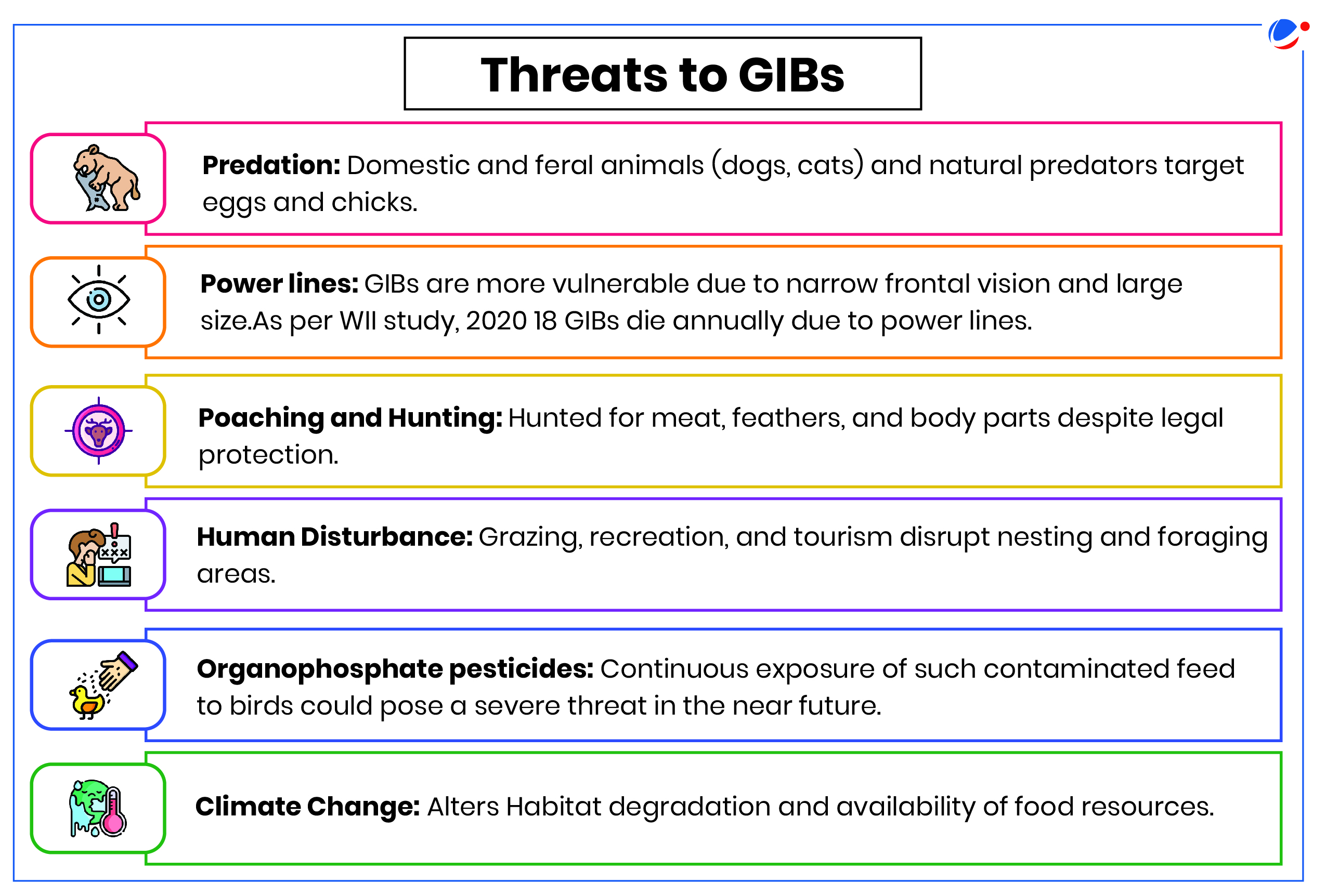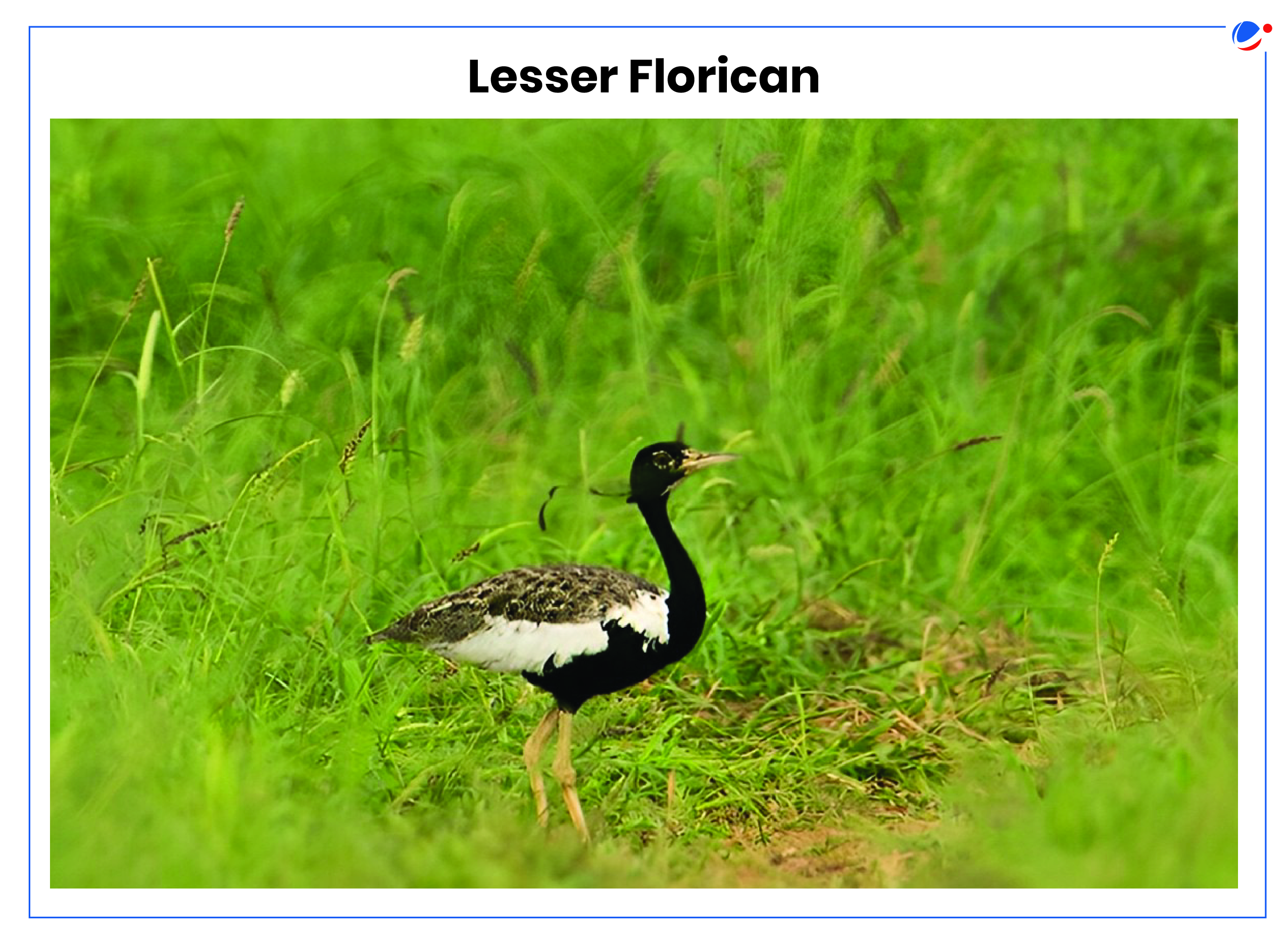Why in the News?
Ministry of Environment, Forest and Climate Change (MoEFCC) approved funds for next phase (from 2024 to 2029) of Bustard Recovery Program.
Bustard Recovery Program
- Coverage of species: Great Indian Bustard (GIB) and Lesser Florican.
- There are four bustard species present in India, other two are Bengal Florican; Macqueen's Bustard.
- Background: Plans to recover the species first started in 2013 under the National Bustard Recovery Plan, which later gave way to the Bustard Recovery Project in 2016.
- The Bustard Recovery Project commenced for an initial period of five years (2016-21) and now extended till 2033.
- Current Status: As of now, around 140 GIBs and fewer than 1,000 Lesser Floricans are surviving in the wild.
- Project implemented by: Wildlife Institute of India
- Funding agency: National Compensatory Afforestation Fund Management and Planning Authority (CAMPA) Authority
- Partner agencies: Ministry of Environment, Forest & Climate Change Rajasthan Forest Department Gujarat & Maharashtra Forest Departments

- Project Objectives:
- Conservation Breeding: Secure ex-situ populations of great Indian bustard and lesser florican.
- Applied Research: Prioritize conservation areas, characterize threats, assess population and habitat status, and evaluate management effectiveness.
- Capacity-Building and Outreach: Improve protection enforcement, sensitize stakeholders, and incentivize local land use.
- Pilot Implementation of Surgical Habitat Management: Demonstrate best practices through experimental interventions.
- Collaborating agencies:
- Bombay Natural History Society: A pan-India wildlife research organization, has been promoting the cause of nature conservation since 1883.
- Conservation of nature, primarily biological diversity through action based on research, education and public awareness.
- Others: International Fund for Houbara Conservation / Reneco; The Corbett Foundation; Humane Society International; Jivdaya Charitable Trust; The Grasslands Trust.
- Bombay Natural History Society: A pan-India wildlife research organization, has been promoting the cause of nature conservation since 1883.
About Great Indian Bustard (GIB)

- Conservation Status
- Wildlife Protection Act, 1972: Schedule I and IV
- IUCN: Critically Endangered
- CITES: Appendix I
- Key Characteristics
- Habitat: Agro-grassland bird endemic to the Indian Subcontinent.
- In India, their population is confined mostly to Rajasthan and Gujarat. Small population occur in Maharashtra, Karnataka and Andhra Pradesh.
- Food Habit: Omnivorous bird, they feed on grass seeds, insects like grasshoppers and beetles, and sometimes even small rodents and reptiles.
- Others
- GIB lacks frontal vision
- Breed mostly during the monsoon season when females lay a single egg on open ground.
- Habitat: Agro-grassland bird endemic to the Indian Subcontinent.
- Importance of GIBs: Considered as indicators of the health of grasslands or pulse of grassland ecosystem.
About Lesser Florican
|
Steps taken for GIBs
- Declaration of Protected areas: Key habitats designated as National Parks/sanctuaries for e.g., Desert National Park, (Rajasthan), Naliya Grassland (Lala Bustard Wildlife Sanctuary)
- Species Recovery Programme: GIBs has been identified for conservation efforts under the 'Species Recovery Programme', which is a centrally Sponsored Scheme for development of Wildlife Habitats.
- Providing financial and technical assistance to states for GIB protection.
- Conservation breeding: Captive population development for wild release and in-situ conservation support.
- For e.g- GIB conservation breeding centres are functioning in Rajasthan's Sam, Ramdevra.
- Legal protection: Included in Schedule-I of the Wild Life (Protection) Act, 1972, which prohibit hunting.
- Capacity Development: Such as training in artificial incubation and insemination techniques.
- For e.g- Personnel were trained in artificial breeding techniques at National Avian Research Centre (NARC), Abu Dhabi in 2022-23.
- Supreme Court Cases: Apex Court also monitoring the GIB and Lesser Florican conservation programme and a petition seeking protection of the two species is pending before it.
Conclusion
Saving the Great Indian Bustard requires multi-level collaboration. This effort extends beyond a single species, aiming to protect whole ecosystems. Addressing complex challenges demands coordinated action for long-term conservation success.







